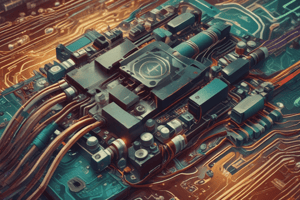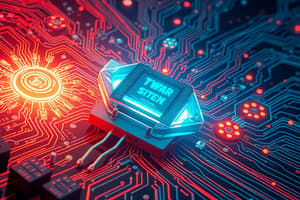Podcast
Questions and Answers
What is the primary characteristic of fixed bias in a BJT?
What is the primary characteristic of fixed bias in a BJT?
- It is dependent on collector resistance for biasing.
- It varies with changes in temperature.
- It maintains a constant base current regardless of transistor type. (correct)
- It relies on a variable resistor for base current control.
How does temperature affect the ICBO in bipolar junction transistors?
How does temperature affect the ICBO in bipolar junction transistors?
- ICBO is inversely proportional to temperature.
- ICBO remains constant regardless of temperature.
- ICBO doubles for every 10°C increase. (correct)
- ICBO decreases for every 10°C increase.
What happens in a fixed bias configuration if the transistor enters saturation?
What happens in a fixed bias configuration if the transistor enters saturation?
- IC is limited by VCEsat. (correct)
- No effect on IC.
- VCE remains constant.
- The Q-point remains unchanged.
What is the back EMF generated in a self-bias circuit primarily influenced by?
What is the back EMF generated in a self-bias circuit primarily influenced by?
In a BJT's large signal model, the collector current IC is primarily controlled by which voltage?
In a BJT's large signal model, the collector current IC is primarily controlled by which voltage?
What is the main consequence of thermal runaway in a BJT?
What is the main consequence of thermal runaway in a BJT?
In the context of a BJT's self-bias voltage divider, what is the Thevenin voltage VTH derived from?
In the context of a BJT's self-bias voltage divider, what is the Thevenin voltage VTH derived from?
How does increasing the collector resistance (RC) affect the BJT's operation?
How does increasing the collector resistance (RC) affect the BJT's operation?
What does the Early effect mathematically represent in terms of collector current?
What does the Early effect mathematically represent in terms of collector current?
In the small signal model, what must be done to constant voltage sources?
In the small signal model, what must be done to constant voltage sources?
Which of the following is true about FETs compared to BJTs?
Which of the following is true about FETs compared to BJTs?
What does a change in voltage V1 affect in a MOSFET?
What does a change in voltage V1 affect in a MOSFET?
Which equation correctly defines output resistance considering the Early effect?
Which equation correctly defines output resistance considering the Early effect?
In the relationship ΔICαΔVC, what condition is significant?
In the relationship ΔICαΔVC, what condition is significant?
What is the primary charge carrier in a Junction Field Effect Transistor (JFET)?
What is the primary charge carrier in a Junction Field Effect Transistor (JFET)?
How is the output current in a FET controlled?
How is the output current in a FET controlled?
How does the collector current (IC) respond to changes in base-emitter voltage (VBE) in a BJT?
How does the collector current (IC) respond to changes in base-emitter voltage (VBE) in a BJT?
What is the primary function of biasing in a BJT circuit?
What is the primary function of biasing in a BJT circuit?
What is transconductance (gmi) in the context of BJTs?
What is transconductance (gmi) in the context of BJTs?
In which scenario does a BJT exhibit a stronger response to a microphone input?
In which scenario does a BJT exhibit a stronger response to a microphone input?
What occurs during small signal operation of a transistor?
What occurs during small signal operation of a transistor?
What is the effect of biasing on the transconductance of a BJT?
What is the effect of biasing on the transconductance of a BJT?
How is the voltage output (Vo) related to the collector current (IC) and load resistance (RL) in the equation Vo = -RLIC?
How is the voltage output (Vo) related to the collector current (IC) and load resistance (RL) in the equation Vo = -RLIC?
Which formula correctly represents the relationship between gm, IC, and VBE?
Which formula correctly represents the relationship between gm, IC, and VBE?
Flashcards
Fixed Bias
Fixed Bias
A BJT biasing method where a fixed DC base current (IB) biases the transistor using a regulated voltage supply (VCC).
Thermal Runaway
Thermal Runaway
A self-sustaining increase in collector current (IC) due to temperature increase in fixed bias circuit causing the transistor to overheat and potentially burn out.
Self Bias (Voltage Divider)
Self Bias (Voltage Divider)
A BJT biasing method using a voltage divider circuit (R1, R2) to provide a base bias voltage (VBB) that varies with collector current.
Thevenin equivalent circuit
Thevenin equivalent circuit
Signup and view all the flashcards
Large Signal Model
Large Signal Model
Signup and view all the flashcards
Collector Current (IC)
Collector Current (IC)
Signup and view all the flashcards
Active Region
Active Region
Signup and view all the flashcards
IC=BIB+(1+B)ICBO
IC=BIB+(1+B)ICBO
Signup and view all the flashcards
BJT Voltage-Dependent Current Source
BJT Voltage-Dependent Current Source
Signup and view all the flashcards
Operating Point (Bias)
Operating Point (Bias)
Signup and view all the flashcards
Transconductance (gm)
Transconductance (gm)
Signup and view all the flashcards
Small Signal Operation
Small Signal Operation
Signup and view all the flashcards
Forward Active Region
Forward Active Region
Signup and view all the flashcards
Amplified Output (Vo)
Amplified Output (Vo)
Signup and view all the flashcards
Load Resistor (RL)
Load Resistor (RL)
Signup and view all the flashcards
Bias Circuit
Bias Circuit
Signup and view all the flashcards
Small Signal Model
Small Signal Model
Signup and view all the flashcards
Early Effect
Early Effect
Signup and view all the flashcards
Output Resistance (ro)
Output Resistance (ro)
Signup and view all the flashcards
FET (Field-Effect Transistor)
FET (Field-Effect Transistor)
Signup and view all the flashcards
JFET (Junction FET)
JFET (Junction FET)
Signup and view all the flashcards
MOSFET (Metal-Oxide-Semiconductor FET)
MOSFET (Metal-Oxide-Semiconductor FET)
Signup and view all the flashcards
Bias current (IC0)
Bias current (IC0)
Signup and view all the flashcards
gm (transconductance)
gm (transconductance)
Signup and view all the flashcards
Study Notes
BJT and FET Characteristics
-
BJT (Bipolar Junction Transistor):
- Early effect: Collector current depends on VCE due to the early effect.
- Typical VA values range from 50 to 300V.
- Punch-through effect: The reverse bias voltage of the CBJ must be within the safe limit, otherwise depletion region contact with emitter region.
- Load line analysis: Vcc - Ic * Rc = Vce; Ic * RL = Vcc - Vce.
- Ic is the quiescent collector current.
-
FET (Field-Effect Transistor):
- Types: JFET (Junction FET) and MOSFET (Metal-Oxide-Semiconductor FET).
- FETs are unipolar transistors that use voltage to control the current flow.
- FETs use the drift of majority carriers to control current, unlike the diffusion current in BJTs.
- FETs have high input impedance.
- FETs have good temperature stability.
-
General Transistor Properties
- Equal increments in base current result in equal increments in collector current.
- Common emitter configuration amplifies both current and voltage.
- Operating point (Q-point) must be considered when using transistors for amplification..
- Thermal runaway: Current increase leads to heat dissipation and further current increase causing transistor damage.
Studying That Suits You
Use AI to generate personalized quizzes and flashcards to suit your learning preferences.




